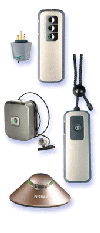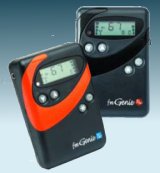Wednesday, May 10, 2006
Radio Aids
 A radio hearing aid effectively 'reduces' the distance between the speaker and the deaf child, whether that speaker is a parent, teacher or anyone in communication with the child. In the usual post-aural hearing aid the microphone is close to the ear of the person wearing the aid. As we have said, this microphone picks up and amplifies all background noise as well as speech. It cannot discriminate between the two. The microphone on a post aural hearing aid becomes less and less effective as the distance between the speaker and the child increases.
A radio hearing aid effectively 'reduces' the distance between the speaker and the deaf child, whether that speaker is a parent, teacher or anyone in communication with the child. In the usual post-aural hearing aid the microphone is close to the ear of the person wearing the aid. As we have said, this microphone picks up and amplifies all background noise as well as speech. It cannot discriminate between the two. The microphone on a post aural hearing aid becomes less and less effective as the distance between the speaker and the child increases. In a radio aid the microphone is separated from the hearing aid and given to the speaker. The subsequent link between the microphone and the receiver on the child's ear is via radio waves.This means that the distance between the spoken word and the microphone is close and constant and there is less opportunity for background noise to be picked and therefore interfere with the speech sounds. The signal transmitted to the hearing aid remains at a constant level regardless of the distance between the speaker and the child.
For these reasons radio aids are particularly beneficial to deaf children in classrooms where there is a lot of background noise. They are also useful outside where the distance between speaker and the child may be greater.

They do have many advantages over post-aural hearing aids, as described earlier, but still they remain an aid to hearing and do not return the hearing to normal.
additional info at: national deaf children's society





